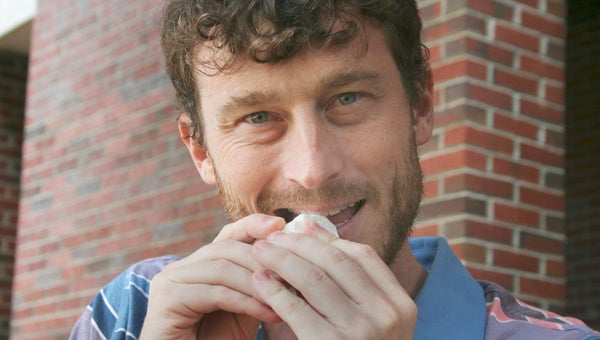Eating Dirt
Published 11:50 pm Friday, September 27, 2013

Adam Forrester, assistant professor of photography/video at Troy University, is creating a documentary titled “Eating White Dirt,” in an effort to give the traditional practice its just due. Below, White dirt is sold in stores all across Alabama, Georgia and South Carolina. But it is usually sold as a novelty and labeled “Not for human consumption.”
Local professor fascinated by traditional practice of consuming white dirt
Everything has a beginning and an ending.
For Adam Forrester, his fascination with the age-old tradition of eating white dirt began when he was running a paper route in Columbus, Georgia. His hope is that his fascination will come to fruition via his “Eat White Dirt” documentary created in an effort to bring sensitivity and understanding to the tradition and cultural practice of eating white dirt.
“There are many quirky, strange traditions that add to the mystery of things,” said Forrester, assistant professor of photography/video at Troy University. “Through this documentary, I hope to give the practice of eating white dirt its due.”
Forrester had just graduated college when he was introduced to white dirt.
“My paper route was in neighborhood where grocery stores were less regulated,” he said. “The owners sold pretty much what they wanted to sell. In almost every one of the small stores, there was a cardboard box with white dirt. I wanted to know why anybody would eat ‘dirt’.”
Forrester, laughingly, said the more he “dug” into the tradition or practice, the more fascinated he became.
The tradition of eating white dirt has a scientific or medical term Forrester said.
“Pica is an eating disorder where there is a craving for things with no nutritional value,” he said. “Geophagy is specific to the earth such as eating white dirt.”
The practice is “traditionally” assigned to the rural areas of the South where poor people would dig the white dirt or chalk from clay banks and eat it for “whatever reason.”
“But the practice actually dates back to ancient Greece,” Forrester said. “And it is mentioned in novels by such noted writers as John Steinbeck and Gabriel Garcia Marquez. In my research, I’ve found that people as far north as New York and as far west as California are eating white dirt.
“So the tradition spans time and culture. It reaches across the globe and into other species.”
As to why people eat white dirt, the practice is rather specific to cravings in pregnant women, but it is believed by some to have medicinal value for others.
Forrester said his research supports the belief that pregnant women do have unnatural cravings for white dirt.
“The pregnant women that I’ve talked to say they crave it,” Forrester said. “One woman said she has to have white dirt and a Coca-Cola everyday. But there’s the possibility that pregnant women eat the white dirt just because their mothers and grandmothers did and it is thought be good for them and their babies.”
The cravings for white dirt could be caused by a mineral deficiency. The white dirt is thought to have a calming effect that would be desirable for pregnant women.
Forrester said Sera L. Young of Cornell University has done extensive research into the tradition of eating white dirt and has found “strange cravings” in pregnant women.
“So it makes you wonder if there’s not something to it,” he said, with a smile.
But white dirt is also thought to be a good digestive aid and an anti-diarrheal.
“White dirt has the ability to coat and sooth the stomach,” Forrester said. “It is absorptive and can absorb toxins in the body. If you have
a virus, it could absorb the virus until it leaves the body.”
However, the medical community warns that too much white dirt could cause anemia.
“Too much white dirt could absorb iron from the blood and cause a deficiency,” he said.
But whether white dirt is being eaten for its almost non-existent mineral properties or to cure a griping stomach, there continues to be a market for it and especially in the South.
“We get white dirt from kaolin mines that are incredibly abundant in a belt of deposits that stretch across Alabama, Georgia and South Carolina,” Forrester said. “The mines are beautiful scenes of mounds of white dirt. Kaolin has many uses including the shiny coating on magazines. It has many industrial applications.
However, the curiosity that surrounds the eating of white dirt is that it is, for the most part, tasteless and odorless.”
But because, white dirt absorbs odors, it often acquires the taste of the odor.
“The white dirt can absorb the odor of the store where it is sold,” Forrester said. “One lady in Georgia told me that there are a lot of stores that sell white dirt in her area but she drives a long distance to buy white dirt that tastes like her favorite store smells.”
Forrester said dirt that is dug fresh from a clay bank might have the taste of fresh rain or of warm sunshine.
“Fresh dug dirt is soft and pliable but, as it loses moisture, it becomes hard and is more chalky to the taste,” he said. “The white dirt that is sold in stores is smooth but hard. And, it is usually sold as a novelty with the wording, ‘Not for human consumption’ on the label. That’s probably done to cover butts.”
White dirt has been around for centuries and, in all likelihood, it will be around as long as there are pregnant women or those who just enjoy the novelty of things.
Forrester’s research continues into the why of eating white dirt. Does white dirt actually have medicinal properties? Is it a mind game pregnant women play? Is if folklore or fact?
“As for me, I can’t discount it,” Forrester said. “There has to be something more to eating white dirt than a craving. If white dirt goes away, how will that affect people? Those unexplainable mysteries make the best stories, don’t they?”



